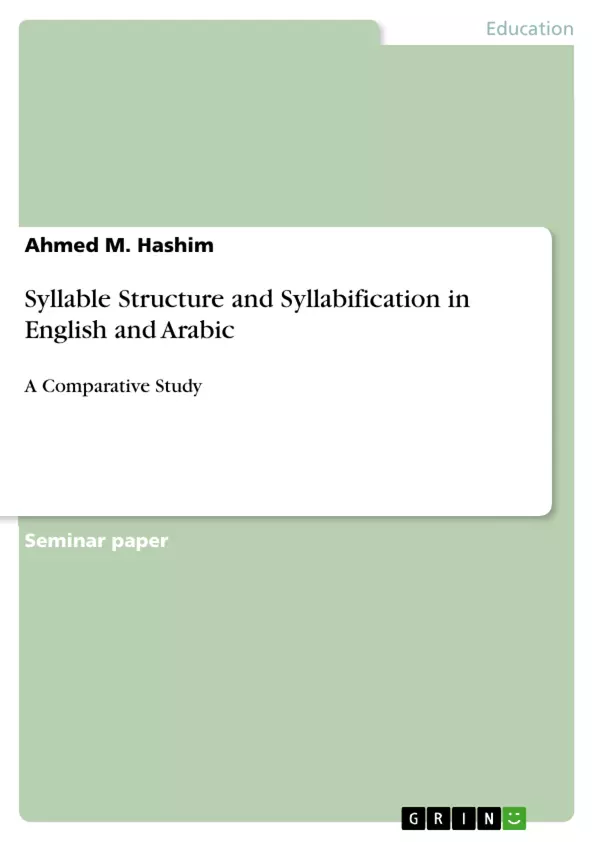This term paper is about the syllable structure and syllabification in both Arabic and English languages. It deals first with what syllabification is and with its principles as well as with the syllable structure of the English language and Arabic and its constituents.
Table of Contents
- Abstract
- Introduction
- Concept of Syllabification
- General Syllabification Principles
- The Obligatory Onset Principle
- The Legality Principle
- The Principle of Irregular Coda
- The Sonority Cycle Principle
- Resyllabification Principle
- The stress principle
- General Syllabification Principles
- Syllable Structure in English
- English Constituents of the Syllable
- Syllable Onset
- Syllable Nucleus
- Syllable Coda
- English Constituents of the Syllable
- Syllables in Arabic
- Rhythm and Syllable in Arabic
- Syllable structure in Modern Standard Arabic
- Conclusion
- References
Objectives and Key Themes
This term paper aims to compare and contrast syllable structure and syllabification in English and Arabic. It investigates the principles governing syllabification and examines the constituent elements of syllables in both languages.
- Definition and principles of syllabification
- Constituent elements of English syllables (onset, nucleus, coda)
- Syllable structure in Arabic and its rhythmic properties
- Comparison of syllable structures in English and Arabic
- Differences in orthographic representation of syllables in English and Arabic
Chapter Summaries
Introduction: This introductory chapter defines the syllable as a unit of pronunciation containing a vowel sound, possibly with surrounding consonants, forming part or all of a word. It contrasts alphabetic languages, where consonants and vowels are linearly arranged, with syllabic languages like Japanese, which use syllabaries. The chapter establishes the paper's focus on comparing syllable structure and syllabification in English and Arabic, highlighting the differences in their orthographic systems.
Concept of Syllabification: This chapter defines syllabification as the process of breaking down polysyllabic words into syllables, governed by phonological rules. It discusses the implications of syllabification for writing and phonological processes. The chapter introduces the concept of analyzing syllable structure through parameters, acknowledging the variation across languages while aiming for a general theory applicable to a wide range of linguistic structures. The chapter also provides a diagram illustrating the typical syllable structure, its hierarchical organization, and an example of syllable analysis.
Syllable Structure in English: This chapter delves into the structure of English syllables, detailing their constituents: onset, nucleus, and coda. Each element is examined in detail, though specifics of each are not included here due to limitations of the available text. The discussion would likely explore the various combinations of consonants and vowels possible within these syllable positions and how they contribute to the overall sound structure of English words.
Syllables in Arabic: This chapter focuses on the syllable structure in Arabic, exploring its rhythm and the structure of syllables in Modern Standard Arabic. The analysis likely includes a discussion of the unique phonological rules and patterns governing Arabic syllable structure, distinguishing it from English. The treatment of vowels as diacritics in Arabic script is likely a key element, contrasting with the alphabetic representation of vowels in English.
Keywords
Syllable, Syllabification, Arabic, English, Onset, Nucleus, Coda, Phonology, Orthography, Rhythm
Frequently Asked Questions: A Comparative Study of Syllable Structure in English and Arabic
What is the main focus of this academic paper?
This paper provides a comprehensive comparison of syllable structure and syllabification in English and Arabic. It investigates the underlying principles governing syllabification and analyzes the constituent elements of syllables in both languages, highlighting similarities and differences.
What are the key themes explored in the paper?
The key themes include defining and explaining the principles of syllabification; detailing the constituent elements of English syllables (onset, nucleus, coda); examining the syllable structure in Arabic and its rhythmic properties; comparing and contrasting syllable structures in English and Arabic; and exploring the differences in the orthographic representation of syllables in both languages.
What are the different chapters covered in this paper?
The paper includes an introduction, a chapter defining the concept of syllabification and its governing principles, chapters dedicated to the syllable structure in English and Arabic respectively, a conclusion, and a list of references. The chapter on syllabification explores principles like the Obligatory Onset Principle, the Legality Principle, the Principle of Irregular Coda, the Sonority Cycle Principle, the Resyllabification Principle, and the stress principle.
How does the paper define and explain syllabification?
Syllabification is defined as the process of dividing words into syllables, guided by phonological rules. The paper explores the implications of syllabification for writing and phonological processes, offering a general theory applicable to various linguistic structures. It also uses diagrams to illustrate typical syllable structures and their hierarchical organization.
What are the key components of a syllable, as discussed in the paper?
The paper identifies the three main constituents of a syllable: the onset (the consonants before the vowel), the nucleus (the vowel), and the coda (the consonants after the vowel). The discussion focuses on how these components combine in both English and Arabic.
How does the paper compare and contrast English and Arabic syllable structures?
The paper compares the syllable structures of English and Arabic, highlighting differences in their phonological rules and patterns. A key difference lies in the orthographic representation of vowels: explicitly represented in English alphabets and as diacritics in Arabic script. The rhythmic properties of syllables are also considered in the comparison.
What are the key words associated with this study?
The keywords include: Syllable, Syllabification, Arabic, English, Onset, Nucleus, Coda, Phonology, Orthography, Rhythm.
What is the overall objective of this academic work?
The paper aims to provide a comparative analysis of syllable structure and syllabification in English and Arabic, offering a structured and detailed understanding of the similarities and differences between these two language systems regarding syllable formation and representation.
- Citar trabajo
- Ahmed M. Hashim (Autor), 2018, Syllable Structure and Syllabification in English and Arabic, Múnich, GRIN Verlag, https://www.grin.com/document/451232



